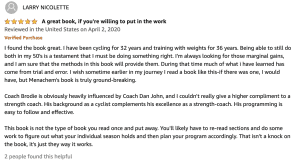Balancing strength training & cycling can seem like an impossible task, but if you understand what you need out of your strength training, it's actually pretty simple.
So you’ve hit the weights this past winter, and are starting to really feel solid on the bike.
Your ride time is beginning to increase as the days get warmer, and while you want to continue strength training, you’re either running out of hours in the day, or are not feeling quite “springy” enough on the bike.
Obviously the strength training has to go- right?
No.
Not at all, actually.
Well, that is unless you’re ok losing whatever gains from the strength you’re reaping in your riding.
What sane-minded person would put in all that work, only to choose to let it all dissipate at the exact time you need it (or want it) most?

Keeping your Strength Training Going
Now that we’ve established that stopping your strength training would be equivalent to your stopping riding your bike the few months before your big event/ weekend is quite literally the WORST thing you can do, the next step is to recognize that mid-season is a GREAT place to be doing small doses of heavy weight training.
If you’ve been following a year-round strength training program to this point, and have been able to be consistent (2-3 days a week) over the last 3 months, then this post is for you.
If you have NOT been consistent in your strength training the last 3 months, you’re making the #1 mistake that cyclists (and triathlete) make then it comes to strength training….
Being inconsistent.

The 2nd most common mistake cyclists and triathletes make when it comes to their strength training, is going all-body weight. While of course IT DEPENDS, we ideally want to continue with medium to heavy loads 1-2 days a week.
Why is this important?
As we’re out on the road, bike, or in the pool getting tons of training volume in our sport, moving our own bodyweight and challenging our energy systems, our nervous system is making constant adjustments and adaptations (if your nutrition, sleep, and recovery to ADAPTATIONS is on point- more on that in another post).
This means our bodies are working to figure out how to do the least amount of work to accomplish the tasks we are asking that.
“That’s a good thing!” You may want to blurt out after you finish your swig of your home-made French Press coffee.

Well, yes, but mostly no.
All of us have developed some kind of movement idiosyncrasies due to our daily activities (or lack there of during CORONA ’20).
The way we sit
The way we sleep
How we run or push the pedals
How we sit on the edge of the sofa while watching the 9th episode of “The Last Dance”
The daily activities and positions we tend to hold are going to be driven in large part by our breathing patterns, strengths, and weaknesses.
Though one would think that cyclists and triathletes would have great postures and positions due to how far/long we can move our bodies, in fact, without careful attention to what’s going on and HOW we are getting the movements, we can find ourselves frequent flyers at the local physical therapists office after just a few years.
But, with what you’re about to read, you can help yourself steer clear of the rocks of overuse and poor technique movements.
Are you ready?

Strength training during the season
Let’s cut right to the last 5km of this exciting article/race.
Here’s what you want to focus on mid-season in your strength training:
- GREAT breathing patterns- This is paramount to performance, recovery, adaptation, and stress management.
The 1 arm Deep Squat Breathing tends to be popular during high ride season, as it allows you to feel your entire body, and help get things a bit more realigned while riding lots.
2. Rack Pulls- During the peak riding season many cyclists and triathletes lose their ability to perform deadlifts off the ground, due to the long hours with their backs rounded, and not much time getting hip extension (Triathletes, I’m looking at you!)
Rack Pulls allow us to add load to the hinge pattern while decreasing the risk of a back injury due to faulty mechanics.
While this was my warm-up set, notice how the bar stays nice and tight next to the body, my shoulders stay back, and my spine straight….finishing each repetition PUSHING THE GROUND to get full hip extension.
Set the bar up just below knee height, and we want to use the rack, so that we have the pins (long rails), that the bar can start/end from, which helps us focus on the important things:
- Full body tension
- Great Technique
- PUSHING THE FLOOR AWAY
- Keeping my midsection appropriately braced
3. Half- Kneeling Pressing- This may come as a surprise to some, but the pressing motion is an integral movement, which allows us to connect the arms with the legs, by learning how to “cross- connect” through our entire midsection to produce stability and stiffness.
Going into a half-kneeling position, where you MUST fire the glutes & midsection appropriately to create stiffness and stability to press overhead, is a grand slam, and a fantastic use of your time.
Due to many cyclists and triathletes having poor overhead pressing patterns, as well as the landmine press allowing for more mid-back recruitment, the Half-Kneeling Landmine Press is a great starting point.
Take the time to get the position correct, and make sure that the back glute is fried, and your toes on the back leg are digging into the ground as if you’re about to sprint. This makes a big difference with the recruitment of the muscles to help you do this right.
4. Weighted Rotary Stability- This is one of my favorite exercises to do mid-season, as not only is it working on the athletes grip strength (a highly underrated piece of strength training), but it also allows us to weed out anychanges in the athletes body working to resist rotation, due to long hours in the saddle, or pool.
For this, I like to put at the END of this short workout, the Suitcase Carry.
Let’s take a listen to Dan John on the Suitcase Carry
While I have my own video on the Suitcase Carry, I learned it from Dan, and well, Dan is someone you should be following alongside me, if you’re looking for no-fluff, no-BS approach to strength training for true performance, and lifelong fitness.
Dan’s written a number of books on strength training, and is a true professional expert in the field. In fact, in his review of my my book “The Vortex Method: The New Rules of Strength Training for Cycling Performance”, Larry gave me what I consider to be the biggest compliment a strength coach + author can get: being mentioned in the same sentence as Dan.


Thank you Larry, as my wife can testify to, I teared up when I read that in your review.
Putting together the strength training routine
That’s it.
Simple (but not easy)
Straight forward.
DONE.
That is what we want out of our strength training mid-season.
Add to these 4 exercises a dynamic warmup working on 3-5 movements or areas that you need to keep working on/oiled, and 3-5 minutes of soft tissue work before that, and you have yourself a 20-30 minute mid-season strength routine that you can use for 6-8 weeks to keep you strong on the bike, and progressing in your performance & abilities.
2-4 sets of 4-8 repetitions for the Rack Pulls and Landmine Presses at an RPe of 6-7 (not including a light warmup set of 8-10 repetitions) and 2-4 sets of the 1 arm deep squat breathing (3-4 breaths/side) and20-30 seconds for the suitcase carries, and you’re golden.






